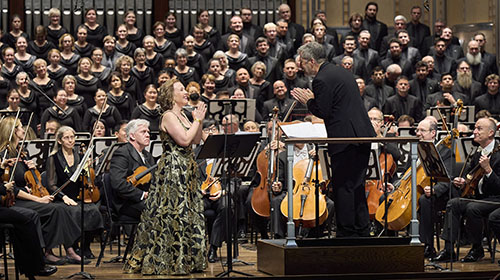HAPPENING THIS WEEKEND:
Nineteen events appear in our Concert Listings for Friday through Sunday, and rather than repeating all of them in this summary, we’re going to send you directly to that page. Click here for details of these and other forthcoming concerts, then enjoy the richness of classical music offerings in Northeast Ohio!
Pictured: Sasha Cooke with Thomas Adès, Cleveland Orchestra & Chorus. Thursday’s performance will be repeated Saturday at 8. Photo by Roger Mastroianni.
WEEKEND ALMANAC:
February 21:
British poet and lyricist W.H. Auden, who provided so many words for Benjamin Britten and Igor Stravinsky to set to memorable music, was born on this date in 1907 in York.
Click here to watch England’s Voces8 perform Britten’s Hymn to St. Cecelia unconducted, with text by W.H. Auden. And if you have a couple of hours to devote to The Rake’s Progress (music by Stravinsky, libretto by Auden and Kallman), here’s a video of a controversial production at the Aix-en-Provence Festival in 1992 directed by Alfredo Arias and conducted by Kent Nagano.
February 22 by Jarrett Hoffman
There’s a long history of visual art influencing the creation of music, and vice versa. One important artist steeped in that cross-pollination is Andy Warhol, that leading figure of the pop art movement who was born in Pittsburgh, and who died on this date in 1987 in New York City at age 58.
Warhol influenced many musicians, including David Bowie, but one more direct connection he had with music was his involvement with the experimental rock group The Velvet Underground. Having heard about them through the grapevine shortly after their formation, he went to hear them play in 1965. Impressed, he offered to be their manager — a partnership that raised the profile of the group significantly.
Soon the band was performing in Warhol’s “Exploding Plastic Inevitable” multimedia shows, which included music and dance alongside the artist’s films. The artist also served as nominal producer for the group’s now-iconic debut album The Velvet Underground & Nico (1967), where they were joined by that German-born singer at Warhol’s insistence.
Featuring a Warhol print of a banana on the front cover, that record also serves as an entry point for a discussion of Warhol’s album artwork, an area in which he was prolific, and highly varied when it came to musical genre. Perhaps his most famous entry was the provocative image that accompanied The Rolling Stones’ Sticky Fingers (1971), which included a working zipper and belt buckle.
In the area of classical music, Warhol designed album covers for figures such as composer and conductor Carlos Chávez and pianist Vladimir Horowitz, and ensembles such as the Indianapolis Symphony, Vienna Philharmonic, Boston Pops, and Philadelphia Orchestra. Warhol cover art collector and researcher Guy Minnebach shares images of the classical album covers in his blog here, and Warhol’s album covers in general here.
Even if you think you aren’t familiar with Warhol’s work, you would probably recognize his vividly-colored series of portraits of Marilyn Monroe. Other celebrities to receive that treatment included Elvis Presley, Muhammad Ali, and — in a different use of the word ‘celebrity’ — Ludwig van Beethoven.
For the 1987 Beethoven series, Warhol began where else but with the famous portrait of that composer by Joseph Karl Stieler, an image you’ll recognize from its use in publications and press materials time and time again. From there, Warhol overlays a sheet of music — an excerpt from the “Moonlight” Sonata — and employs his signature, dramatic color scheme. Click here and scroll down, past the Mick Jagger material, to view the Beethoven series from the Masterworks Fine Art Gallery in San Francisco.
February 23:
German-British composer George Frideric Handel was born on this date in 1685 in Halle (in what was then Brandenburg-Prussia). He moved to London in his late twenties and spent the majority of his career there, becoming a British citizen fifteen years later. Naturally London was also the location of many premieres of important works, including the oratorio Esther, which was first performed on this same date in 1732 on Handel’s 47th birthday.
Click here to watch a performance of the famous aria “Tune your harps with cheerful noise” in the hands of San Francisco’s early music ensemble Voices of Music. Thomas Cooley is the tenor, and Marc Schachman is the Baroque oboist.
Handel makes an interesting counterpart to Edward Elgar, who passed away on this date in 1934. Although Elgar was English by birth, he nevertheless felt like an outsider there, being self-taught, having grown up relatively poor, and being Roman Catholic in a heavily Protestant country. Indeed there was some discomfort early on around his choral work The Dream of Gerontius (now deeply embedded in the canon) since it sets text from a poem that explores the afterlife through a Catholic lens. Getting performances was not always easy, and in some cases a revised text was used.
Click here to listen to the “Demon’s Chorus” from that work here, excerpted from a performance at the Southwell Music Festival in 2016.




